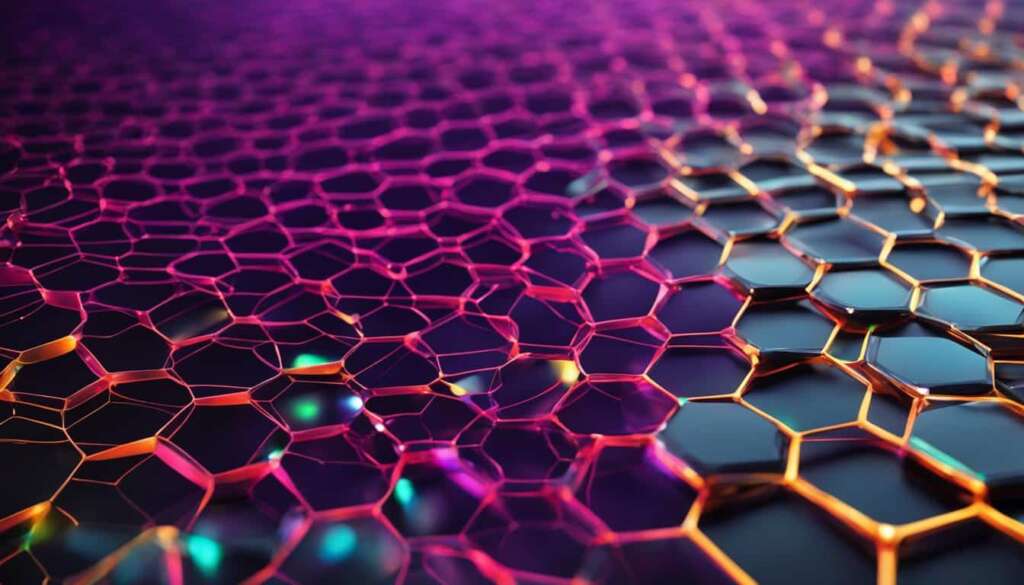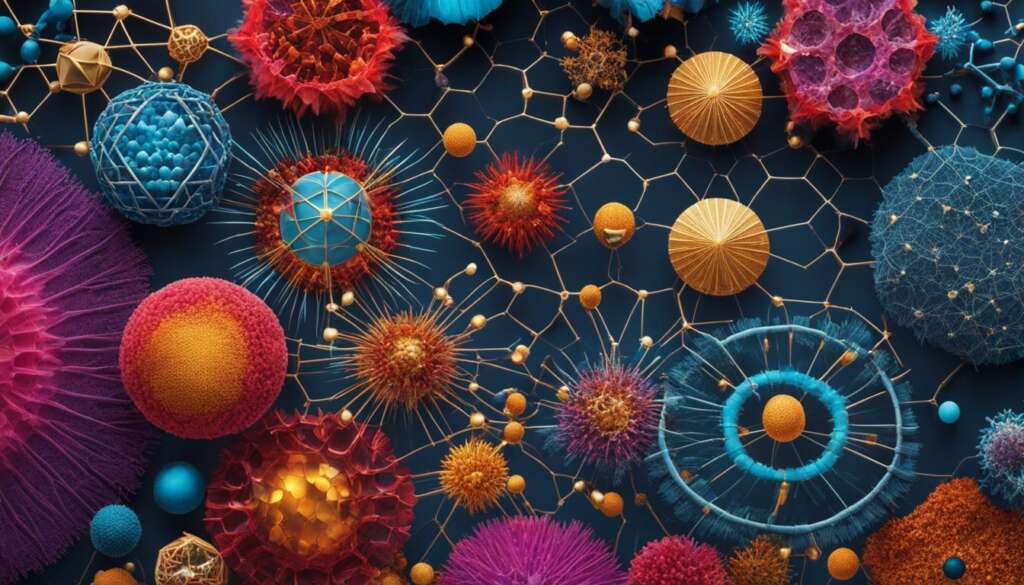Table of Contents
Graphene, a two-dimensional carbon monolayer, has emerged as a revolutionary material in the field of nanotechnology. Compared to other nanomaterials, graphene offers superior characteristics and has garnered significant interest in various industries, particularly healthcare. Its unique properties make it a versatile material that can be used in the development of new drug delivery systems and biomedical applications.
The European Union Research Council has recognized the potential of graphene and has initiated the EU Graphene Flagship to boost fundamental research in this field. Graphene and its derivatives have shown immense potential in improving the mechanical and electrical properties of composite materials, making it a valuable material in frontier medicine.
Key Takeaways
- Graphene is a two-dimensional carbon monolayer with revolutionary applications in various industries, including healthcare.
- Graphene offers unique properties that make it suitable for drug delivery systems and biomedical applications.
- The EU Graphene Flagship initiative aims to boost fundamental research in graphene nanotechnology.
- Graphene and its derivatives have the potential to enhance the mechanical and electrical properties of composite materials.
- Frontier medicine can benefit from the versatile properties of graphene in developing advanced technologies and treatments.
The Role of Graphene in Drug Delivery Systems
Graphene and its derivatives have been extensively studied for their use in drug delivery systems. Nanomedicine has provided a secure platform for the development of advanced drug delivery systems, and graphene-based nanocarriers have shown great promise in this field.
Various nanomaterials, such as superparamagnetic iron oxide nanoparticles and organic and inorganic nanomaterials, have been used as drug carriers in conjunction with graphene.
The unique features of graphene, such as its high conductance and photothermal healing capability, make it an ideal candidate for drug delivery applications.
Graphene oxide, a derivative of graphene, has been studied for its potential as a biomarker sensor for cancer and its ability to deliver drugs in a controlled manner.
Graphene in Biomedical Applications
Graphene, with its remarkable properties, has found applications in various biomedical fields. Its high electrical conductivity and flexibility make it suitable for the development of sensors in the chemical and biochemical industries. Additionally, graphene has been utilized in the fabrication of photovoltaic cells and liquid crystal displays, where its unique characteristics enhance device performance.
Moreover, graphene’s exceptional properties make it an ideal material for biodevices in biomedical applications. Its high electrical conductivity allows for accurate sensing and detection, while its flexibility enables the creation of wearable and flexible devices that can conform to different body shapes and movements. These devices have the potential to revolutionize healthcare by enabling continuous monitoring of vital signs and delivering real-time data to healthcare professionals.
Furthermore, graphene’s photothermal healing properties make it a promising candidate for wound healing applications. Its ability to convert light into heat can be harnessed to enhance the healing process and reduce infection risks. Graphene’s bacterial inhibition properties also show potential in combatting drug-resistant bacteria, providing a new approach in the fight against antibiotic resistance.
In addition to its sensing and healing capabilities, graphene exhibits excellent drug transport properties. Its large surface area and ability to efficiently cross the cell membrane make it an effective vehicle for targeted drug delivery in cancer treatments. Graphene nanosystems can be engineered to encapsulate and release therapeutic agents precisely at the desired site, minimizing side effects and improving treatment efficacy.
Moreover, graphene’s gene therapy capabilities hold promise for the treatment of genetic disorders. Its unique properties enable efficient delivery of therapeutic genes into cells, offering potential solutions for genetic diseases that currently lack effective treatments.
With the increasing research efforts in the field of graphene nanotechnology, the biomedical applications of graphene are expected to expand further. Ongoing studies aim to explore new possibilities for graphene in diagnostics, regenerative medicine, and personalized healthcare.
“Graphene’s unique properties make it an exciting material for biomedical applications. Its versatility and potential for innovation hold great promise for the future of healthcare.” – Dr. Emily Smith, Biomedical Research Scientist
Biomedical Applications of Graphene
| Application | Description |
|---|---|
| Sensors | Graphene-based sensors for chemical and biochemical industries. |
| Photovoltaic Cells | Utilizing graphene in the fabrication of efficient solar cells. |
| Liquid Crystal Displays | Enhancing the performance of displays using graphene. |
| Wound Healing | Utilizing graphene’s photothermal properties for improved healing. |
| Bacterial Inhibition | Employing graphene’s antibacterial properties to combat drug-resistant bacteria. |
| Drug Delivery Systems | Using graphene as a platform for targeted and controlled drug delivery. |
| Gene Therapy | Exploring graphene’s potential in delivering therapeutic genes for genetic disorders. |
Recent Advances in Graphene Research
Recent studies have explored the exciting potential of graphene in various areas, pushing the boundaries of research and innovation. Graphene, with its exceptional properties, has demonstrated remarkable advancements in several fields, including fire detection, radiant heating, rechargeable batteries, microphones, regenerative capabilities, and graphene synthesis.
Fire Detection
Graphene’s high electron mobility and thermal conductivity make it an effective material for faster and more reliable fire detection. Its ability to quickly detect and respond to changes in temperature and conductivity has the potential to revolutionize fire safety systems.
Radiant Heating
Graphene also shows promise as a more energy-efficient heat source for radiant heating applications. Its high conductivity allows for efficient heat transfer, enabling improved heating performance and energy savings.
Rechargeable Batteries
Graphene’s high electrical conductivity offers significant potential for enhancing the performance of rechargeable batteries. By incorporating graphene into battery systems, it is possible to improve energy storage, increase battery life, and enhance overall efficiency.
Microphones
The development of miniaturized graphene-based microphones has been a groundbreaking achievement in the field of electronics. Graphene’s high conductivity and exceptional mechanical properties make it an ideal material for improving microphone performance, enabling better sound quality and sensitivity.
Regenerative Capabilities
Researchers have studied graphene hydrogels for their regenerative capabilities in cartilage regeneration. Graphene hydrogels show promise in promoting the growth of chondrocytes and collagen formation, making them a valuable material for tissue engineering applications.
Graphene Synthesis
In pursuit of greener and more sustainable approaches, researchers are exploring the use of natural plant-based resources and biowaste for graphene synthesis. This eco-friendly approach aims to reduce environmental impact and promote the use of renewable resources.
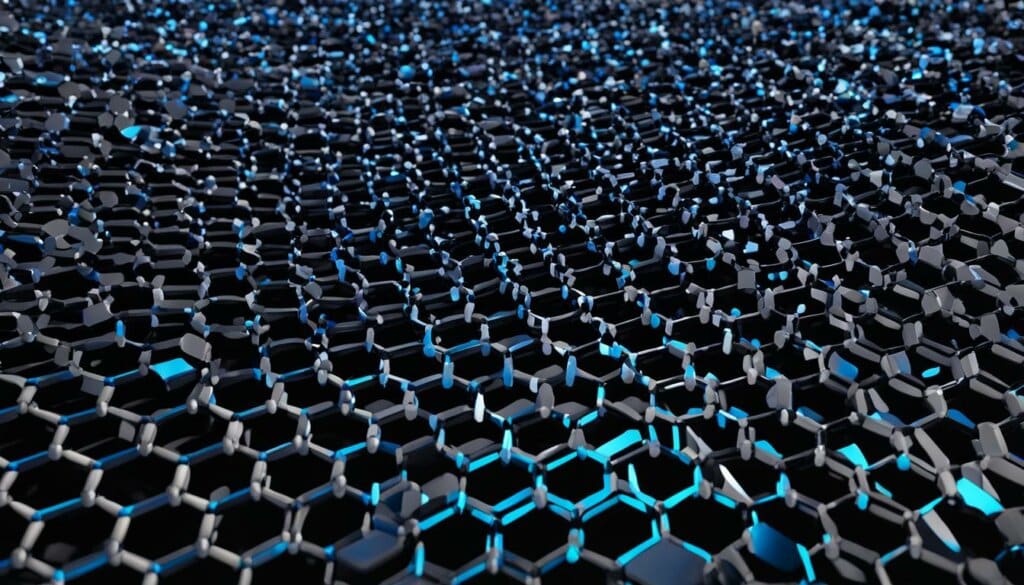
Through these recent advances and ongoing research, graphene continues to push the boundaries of possibilities in various industries. Its remarkable properties and versatility make it a material with immense potential for revolutionizing technology and impacting numerous fields.
Graphene in Electronics and Energy Applications
Graphene, with its exceptional properties, has demonstrated significant potential in the field of electronics. Its high electrical conductivity and nanometer thinness make it an ideal material for developing flexible and stretchable electronic devices, which are crucial for the advancement of wearable technology. With the ability to conform to various shapes and sizes, graphene-based materials enable the creation of innovative electronic applications that enhance user experience and pave the way for technological progress.
Moreover, graphene has emerged as a promising candidate for energy storage systems. Its high conductivity and large surface area make it an attractive material for improving the performance of batteries and supercapacitors. By harnessing the remarkable properties of graphene, researchers are exploring novel approaches to enhance energy storage efficiency, increase battery life, and enable rapid charging.
Graphene-based materials are being developed for various electronic applications across industries. From flexible displays and touchscreens to sensors and transistors, the versatility of graphene allows for the creation of cutting-edge electronic devices that push the boundaries of technological innovation.
One example of the potential of graphene in electronic applications is its use in flexible electronics. By integrating graphene into flexible substrates, researchers have been able to develop bendable and stretchable electronic devices that can be seamlessly integrated into clothing, medical devices, and even wearables for athletes. These flexible electronics not only enhance user comfort but also open up new possibilities for the integration of electronics into everyday objects.
Advancements in Graphene Electronics
Graphene-based transistors, often referred to as “graphene field-effect transistors” (GFETs), have shown promising performance in terms of high operational speed, low power consumption, and excellent electrical properties. These advancements have the potential to revolutionize the field of electronics, enabling faster and more efficient electronic devices.
Another significant area of development is the use of graphene in energy conversion devices such as photovoltaic cells. Graphene has exceptional optical properties that make it an ideal material for enhancing the efficiency and performance of solar panels. Its ability to conduct both electricity and heat efficiently makes it a valuable component in the conversion of solar energy into electrical energy.
Graphene for Energy Storage
Graphene’s unique properties also make it an excellent material for energy storage applications. For example, research has shown that graphene can significantly improve the performance of batteries and supercapacitors. The large surface area of graphene allows for more efficient energy storage, leading to longer battery life and enhanced power output.
In addition, its high electrical conductivity enables faster charging and discharging rates, addressing one of the key limitations of conventional energy storage devices. As a result, graphene-based batteries and supercapacitors have the potential to revolutionize various industries, including electric vehicles, renewable energy, and portable electronic devices.
In Summary
Graphene’s versatility and exceptional properties position it as a material of great significance in the fields of electronics and energy. Its high electrical conductivity, flexibility, and thinness enable the development of flexible electronic devices that can be seamlessly integrated into various applications. Furthermore, graphene-based materials show great promise in improving energy storage efficiency and revolutionizing battery technology. As research and development efforts continue, the potential for graphene in electronics and energy applications is vast, paving the way for technological advancements and sustainable energy solutions.
Graphene in Biomedicine and Healthcare
Graphene-based materials are at the forefront of revolutionizing biomedicine and healthcare. Through extensive research and development, graphene derivatives are unlocking the potential for biomedical breakthroughs. One area of focus is the exploration of graphene hydrogels as scaffolds for cartilage regeneration, presenting a promising solution for tissue engineering.
Graphene hydrogels offer significant advantages in cartilage regeneration due to their ability to promote the proliferation of chondrocytes and enhance collagen formation. These properties make them an ideal material for tissue engineering applications and hold great potential for addressing cartilage-related health issues.
Moreover, the unique properties of graphene and its derivatives enable the development of biocompatible porous structures suitable for various medical applications. These structures provide a favorable environment for cell growth and tissue integration, facilitating advancements in regenerative medicine, implantable devices, and drug delivery systems.
Research in the field of graphene-based biomedical materials continues to drive innovation and pave the way for transformative solutions in healthcare. By harnessing the extraordinary properties of graphene derivatives, scientists and engineers are charting new territory in the development of biocompatible, efficient, and effective materials for medical applications.
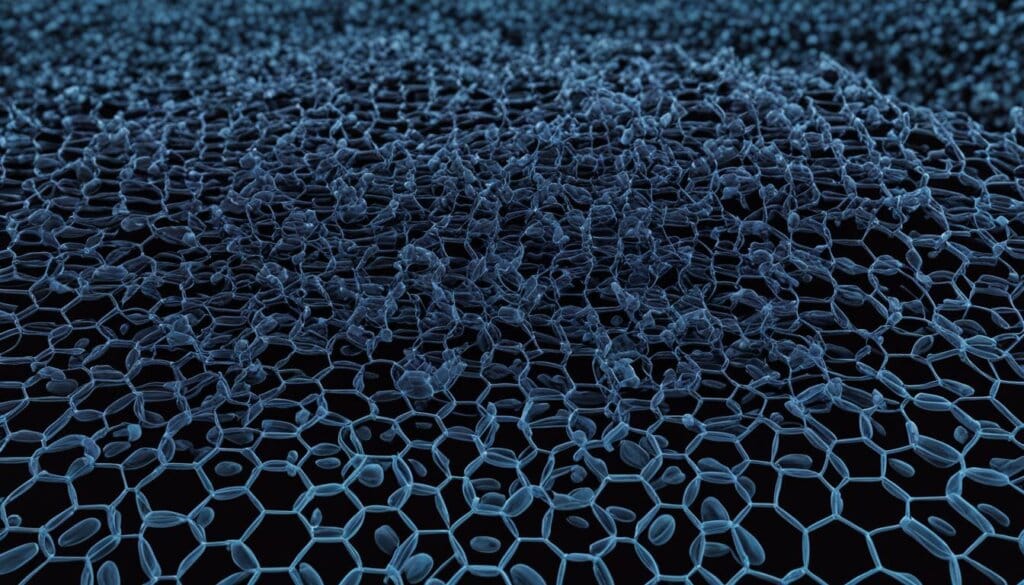
Advantages of Graphene in Biomedical Applications:
- Promotes cartilage regeneration and tissue engineering
- Enhances collagen formation and supports cell growth
- Enables the development of biocompatible porous structures
- Aids in the advancement of regenerative medicine and implantable devices
- Offers opportunities for cutting-edge drug delivery systems
Graphene-based materials hold immense promise in the realm of biomedicine and healthcare, owing to their unique properties and potential for groundbreaking applications. As research and development continue, the integration of graphene derivatives into medical solutions is poised to revolutionize various aspects of healthcare, from regenerative medicine to drug delivery systems.
Green Synthesis of Graphene-based Materials
As the use of graphene-based materials becomes more widespread, there is a growing need for a sustainable approach in their synthesis. Researchers are exploring the use of natural resources and biowastes to produce graphene-based materials, reducing the reliance on traditional manufacturing methods that consume valuable natural resources. By utilizing renewable resources, such as biomass and agricultural waste, a more environmentally friendly synthesis process can be achieved.
The development of safe synthetic processes is also crucial in the production of graphene-based materials. Efforts are being made to minimize the use of hazardous chemicals and implement safer manufacturing techniques. This ensures that the synthesis process not only reduces environmental impact but also prioritizes the health and safety of workers involved in graphene production.
“The transition to sustainable graphene production poses challenges; however, it is a necessary step towards the widespread adoption of graphene-based materials,” says Dr. James Turner, a leading researcher in green synthesis methods.
By adopting a sustainable approach and employing safe synthetic processes, the graphene industry can minimize its environmental footprint and contribute to a more sustainable future. The utilization of natural resources and the development of greener synthesis methods are vital in advancing the production and application of graphene-based materials.
Advantages of Green Synthesis of Graphene-based Materials:
- Reduces reliance on limited natural resources
- Minimizes environmental impact
- Promotes the use of renewable resources
- Improves health and safety in graphene production
- Contributes to a sustainable future
Challenges and Future Perspectives
The transition to sustainable graphene production is not without its challenges. The development of efficient and cost-effective green synthesis methods requires continued research and innovation. Additionally, the scalability of these processes to meet commercial manufacturing demands presents a significant hurdle.
Despite these challenges, the future prospects for the green synthesis of graphene-based materials are promising. Continued efforts in research and development will pave the way for more sustainable and environmentally friendly manufacturing processes. By addressing these challenges head-on, the graphene industry can drive innovation and revolutionize various industries with the widespread adoption of graphene-based materials.
Graphene and Antibacterial Properties
Graphene and graphene oxide have shown significant potential in the field of antibacterial applications. Researchers have particularly focused on studying the antibacterial properties of graphene oxide. The presence of oxygen-containing functional groups in graphene oxide plays a crucial role in determining its antibacterial effects.
Studies have revealed that highly oxidized graphene oxide exhibits superior antibacterial effects compared to graphene materials with lower levels of oxidation. The oxygen-containing functional groups on graphene oxide interact with bacterial membranes, leading to the disruption of membrane integrity and ultimately causing bacterial death.
This research breakthrough opens the door to the development of graphene-based antibacterial agents capable of combating pathogenic microbes. By leveraging the antibacterial properties of graphene oxide, scientists can potentially create innovative solutions for various applications in healthcare, sanitation, and disease prevention.
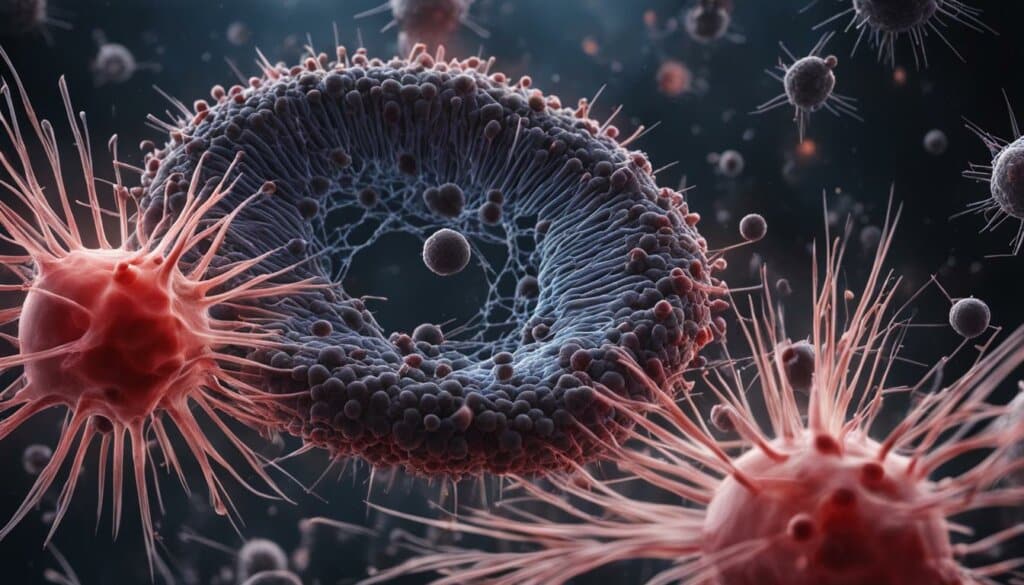
Graphene Oxide and Antibacterial Mechanisms
“The oxygen-containing functional groups on graphene oxide interact with bacterial membranes, leading to the disruption of membrane integrity and ultimately causing bacterial death.”
The antibacterial effects of graphene oxide are primarily attributed to two key factors:
- Direct Contact: Graphene oxide particles come into direct contact with bacterial cells, promoting physical interactions between the two. These interactions lead to membrane damage and the leakage of intracellular components, resulting in bacterial cell death.
- Reactive Oxygen Species (ROS) Generation: The oxygen-containing functional groups on graphene oxide facilitate the generation of ROS, which are highly reactive molecules that can cause oxidative stress in bacterial cells. ROS-induced oxidative stress damages key cellular components and metabolic processes, leading to bacterial cell death.
These antibacterial mechanisms make graphene oxide a promising material for a wide range of applications, including antimicrobial coatings, wound dressings, and drug delivery systems.
Applications of Graphene-based Antibacterial Agents
Graphene-based antibacterial agents hold immense potential in various industries and applications. Some notable examples include:
- Healthcare: Graphene-based materials can be incorporated into medical devices, such as catheters and implants, to prevent bacterial infections.
- Water Treatment: Graphene-based filters can efficiently remove bacteria and other microorganisms from water, ensuring safe drinking water.
- Food Packaging: Antibacterial coatings derived from graphene can be applied to food packaging materials to enhance food safety and extend shelf life.
- Textiles: Graphene-based antibacterial coatings can be used in the textile industry to develop antimicrobial clothing and fabrics.
As research in the field continues to progress, the development of graphene-based antibacterial agents is expected to revolutionize multiple sectors, contributing to improved health and well-being.
| Advantages of Graphene-based Antibacterial Agents | Applications |
|---|---|
| Superior antibacterial effects | Medical devices |
| Enhanced durability and longevity | Water treatment |
| Efficient bacterial removal | Food packaging |
| Improved safety and functionality | Textiles |
Graphene in Biomedical Applications: Drug Delivery Systems
Graphene-based nanocarriers hold promise in the field of drug delivery systems. These nanocarriers can enhance drug loading and release, resulting in more effective therapeutic interventions. The unique structure of graphene, combined with the incorporation of other nanoscale building blocks such as nanoparticles and polymers, offers new possibilities for personalized medicine and enhanced biomedical applications.
Graphene-based drug delivery systems have the potential to protect drugs, increase their therapeutic effectiveness, and minimize side effects on normal tissues. By leveraging the properties of graphene nanocarriers, such as their high surface area, exceptional mechanical strength, and tunable surface chemistry, drugs can be encapsulated and delivered in a controlled manner.
Personalized medicine can benefit from the development of graphene-based drug delivery systems. These systems can be tailored to specific patients and their unique needs, enabling a targeted approach to treatment. By encapsulating drugs within graphene nanocarriers, personalized dosages can be administered, optimizing therapeutic outcomes.
Graphene-based drug delivery systems have immense potential in the field of personalized medicine. By harnessing the properties of graphene nanocarriers, we can improve drug loading and release, leading to more effective treatments while minimizing side effects.
The use of graphene nanocarriers also opens up opportunities for innovative drug delivery strategies. By functionalizing the surface of graphene with targeting ligands or stimuli-responsive materials, drugs can be released at specific sites within the body or in response to external stimuli. This targeted drug delivery approach allows for precise control and can improve therapeutic outcomes.
To illustrate the potential of graphene in drug delivery systems, Table 1 summarizes the current research in this area:
| Application | Findings |
|---|---|
| Cancer Treatment | Graphene nanocarriers loaded with anticancer drugs have shown enhanced therapeutic efficacy and reduced systemic toxicity. |
| Gene Therapy | Graphene-based delivery systems have exhibited efficient delivery of genetic material, opening new avenues for gene therapy. |
| Antibiotic Delivery | Drug-loaded graphene nanosheets have demonstrated prolonged antibacterial activity, providing a potential solution for combating antibiotic resistance. |
Figure 1 showcases a graphical representation of graphene nanocarriers in the context of drug delivery systems:
The development of graphene nanocarriers in drug delivery systems is a rapidly expanding field with significant potential. Researchers are exploring ways to optimize the structure and properties of graphene-based nanocarriers to improve drug loading, release kinetics, and targeted delivery. By harnessing the capabilities of graphene, personalized medicine can be advanced, enabling tailored treatment approaches for patients.
Challenges and Future Perspectives of Graphene Nanotechnology
While graphene nanotechnology holds great promise, it also faces several challenges that must be addressed for its widespread adoption. One of the key challenges lies in integrating graphene into commercial manufacturing processes, ensuring sustainable and cost-effective methods of large-scale production for the successful commercialization of graphene-based materials. The graphene industry requires efficient production techniques that can meet the growing demand without compromising on quality.
The safety and biocompatibility of graphene also demand thorough evaluation to ensure its safe use in biomedical applications. As graphene-based materials find their way into various industries, it is crucial to understand their potential health and environmental impacts, and take necessary precautions to mitigate any risks.
Despite these challenges, the future perspectives for graphene nanotechnology are promising. Ongoing research efforts are aimed at overcoming the obstacles and unlocking the full potential of graphene. Continuous advancements in scientific knowledge, technological innovation, and collaborative initiatives are driving progress in the graphene industry, paving the way for a wide range of applications in various sectors.
“The future belongs to those who believe in the beauty of their dreams.” – Eleanor Roosevelt
One of the future prospects in the commercialization of graphene lies in the development of efficient and scalable manufacturing processes. Researchers and industry experts are constantly striving to optimize production methods and reduce costs to make graphene-based materials economically viable for mass production.
Furthermore, the utilization of graphene in energy storage, electronics, and healthcare industries holds immense potential for future applications. As advancements continue, graphene is expected to play a crucial role in the development of flexible electronics, high-performance batteries, and personalized medicine. These breakthroughs are poised to revolutionize their respective industries and enhance the quality of life for individuals worldwide.
Current Challenges in Graphene Nanotechnology:
- Integration of graphene into commercial manufacturing processes for large-scale production
- Ensuring safety and biocompatibility of graphene in biomedical applications
- Optimizing manufacturing techniques for cost-effective production
- Addressing the potential health and environmental impacts of graphene-based materials
| Challenges | Future Perspectives |
|---|---|
| Integration into commercial manufacturing processes | Scalable and cost-effective methods |
| Safety and biocompatibility | Thorough evaluation and risk mitigation |
| Manufacturing optimization | Efficient and economical production |
| Health and environmental impacts | Understanding and minimizing potential risks |
In conclusion, the challenges faced by graphene nanotechnology are significant, but not insurmountable. The future perspectives for the graphene industry are bright, with ongoing research and development efforts focused on overcoming these challenges. By addressing the integration of graphene into commercial manufacturing processes, ensuring safety and biocompatibility, optimizing manufacturing techniques, and considering the potential health and environmental impacts, the full potential of graphene can be harnessed across various industries, leading to technological advancements and innovative solutions.
Conclusion
Graphene nanotechnology has emerged as a revolutionary field, unlocking a plethora of advancements and revolutionary applications. The remarkable properties of graphene have paved the way for groundbreaking developments in healthcare, electronics, energy, and biomedicine. With its high conductivity, flexibility, and biocompatibility, graphene demonstrates its immense potential in various industries.
Although commercial manufacturing processes and safety evaluations present challenges, the future of graphene nanotechnology looks promising. Continued research and innovation in this field will drive further advancements and revolutionize industries across the globe. As graphene continues to be studied and its capabilities expanded, it is expected to play a pivotal role in shaping the future of technology and science.
In conclusion, graphene nanotechnology holds the key to transformative discoveries. Its versatile nature enables it to be a game-changer in the development of novel materials, devices, and systems. With ongoing research and investment, the revolutionary applications of graphene will continue to unfold, positively impacting various sectors and improving countless facets of our lives.
FAQ
What is graphene nanotechnology?
Graphene nanotechnology refers to the field of study and application of graphene, a two-dimensional carbon monolayer, in various industries. Graphene, a revolutionary material in nanotechnology, offers superior characteristics and has garnered significant interest in healthcare, electronics, energy, and biomedicine.
What are some revolutionary applications of graphene nanotechnology?
Graphene nanotechnology has found applications in healthcare, electronics, energy, and biomedicine. It is being used in the development of new drug delivery systems, sensors for the chemical and biochemical industries, photovoltaic cells, liquid crystal displays, and flexible electronic devices. Graphene also holds promise for enhancing the performance of rechargeable batteries and developing miniaturized microphones.
How is graphene used in drug delivery systems?
Graphene-based nanocarriers have shown promise in drug delivery systems. These nanocarriers can improve drug loading and release, leading to more effective therapeutic interventions. Graphene’s unique structure, combined with the addition of other nanoscale building blocks, such as nanoparticles and polymers, enhances biomedical applications and personalized medicine.
What are the applications of graphene in biomedical fields?
Graphene has been used to develop sensors for the chemical and biochemical industries, as well as in the fabrication of photovoltaic cells and liquid crystal displays. Its high electrical conductivity and flexibility make it a suitable material for biodevices. Additionally, graphene exhibits photothermal healing properties, bacterial inhibition, drug transport, and gene therapy capabilities, making it valuable in frontier medicine.
What recent advances have been made in graphene research?
Recent studies have explored the potential of graphene in faster fire detection, more energy-efficient radiant heating, performance improvement of rechargeable batteries, development of miniaturized microphones, and regenerative capabilities in cartilage. Researchers are also exploring greener approaches for graphene synthesis using natural resources and biowastes.
How is graphene used in electronics and energy applications?
Graphene can be used to develop flexible and stretchable electronic devices, crucial for the advancement of wearable technology. It also holds potential in energy storage, improving the performance of batteries and supercapacitors. Graphene-based materials are being developed for various electronic applications, highlighting the versatility of this material in the field of energy.
What is the role of graphene in biomedicine and healthcare?
Graphene derivatives have been investigated for their potential in promoting biomedical breakthroughs. For example, graphene hydrogels have shown promise as scaffolds for cartilage regeneration, enhancing collagen formation and promoting cell proliferation. Graphene offers opportunities for the development of biocompatible porous structures and advancement in medical applications.
Are there sustainable methods for synthesizing graphene-based materials?
Researchers are exploring the use of natural resources and biowastes for the synthesis of graphene-based materials, aiming to reduce the environmental impact of production and promote the use of renewable resources. Additionally, efforts are being made to develop safer synthetic processes for graphene synthesis.
Do graphene and graphene oxide have antibacterial properties?
Graphene oxide, in particular, has been studied for its antibacterial properties. The presence of oxygen-containing functional groups in graphene oxide determines its antibacterial effects. Highly oxidized graphene oxide exhibits superior antibacterial effects compared to graphene materials with lower levels of oxidation.
How do graphene nanocarriers enhance drug delivery systems?
Graphene nanocarriers improve drug loading and release in drug delivery systems, leading to more effective therapeutic interventions. These nanocarriers protect drugs, enhance therapeutic effectiveness, and reduce side effects on normal tissues, offering the potential for personalized medicine.
What are the challenges and future perspectives of graphene nanotechnology?
One of the key challenges is the integration of graphene into commercial manufacturing processes, requiring sustainable and cost-effective methods of large-scale production. Additionally, the safety and biocompatibility of graphene need to be thoroughly evaluated for its use in biomedical applications. Despite these challenges, ongoing research efforts aim to overcome them and unlock the full potential of graphene in various industries.

